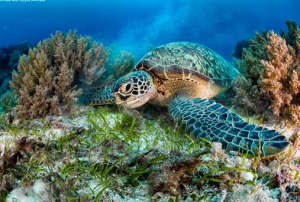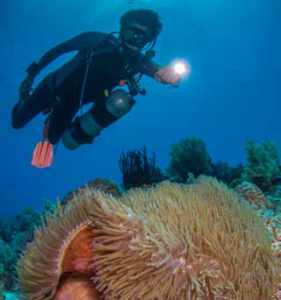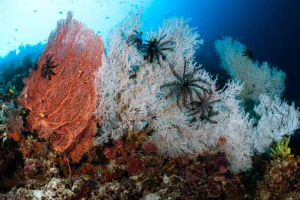 Soft adventurer RODERICK EIME delights in the simple pleasures of Bohol in the Philippines.
Soft adventurer RODERICK EIME delights in the simple pleasures of Bohol in the Philippines.
The morning sun begins to bathe us in a balmy warmth as the clunky old diesel engine throbs a steady beat somewhere beneath the planks on the deck. Our skipper squints into the distance while the deckhands snooze on piled rags.
We’re heading out to into the Bohol Sea from our swank digs at Amorita Resort aboard a local ‘banca’ boat in search of wild dolphins. These boats have been the staple maritime transport for Filipinos for centuries, adapted and modernised as new technology – like internal combustion engines – became available. Travelling among more than 7,000 islands of the archipelago required easilymaintained, lightweight vessels able to be handled by just a few men and range in size from basic 4m fishing canoes to large passenger ferries up to 50m.
The men crewing our vessel come from the tiny island of Pamilcan, about 12km offshore from the larger resort island of Bohol where we meet some of the families who exist on subsistence fishing supplemented by taking tourists like us on day cruises. My guide tells me the population is around 1,000 people living in some 300 households in an almost circular landmass about a kilometre in diameter.
Their village sits in the shadow of a massive 200-something year old stone structure that dates back to the Spanish occupation which, I’m told, was part of a network of five similar watchtowers used by the colonial occupiers to warn against pirates who would raid from Mindanao just to the south.
These families provide labour to the many banca boat operators in the region as well as operating their own tiny fleet for these dolphin and whale watching tours. In days past, the islanders would hunt whales and manta rays whereas today they maintain a marine sanctuary and manage nearby dive sites like Cervera Shoal, known for sea snakes, eels and massive bucket sponges.
In fact, many of the attractions of the area lie beneath the waves, with regions like Bohol in Northern Mindanao playing host to some of the best scuba diving in the Pacific, if not the world. Now before you reel back with the boastfulness of that assertion, know that I consulted many experts in this matter before going to press. One such expert whose every word I ended up hanging off was the doyenne of diving here in the Philippines, Lynn Funkhouser.
“After checking out the diving in many great places, my favorite place in the whole world is the Philippines,” said Lynn, “I’ve followed my heart and spent two months here every year since 1976. Because it lies in the Coral Triangle (along with parts of Indonesia and New Guinea), it missed an ice age 18,000 years ago. This explains why the Philippines has the richest species diversification in the world and I love seeing new critters almost every dive.”
 Not satisfied with her word, I spent several hours beneath the waves checking this out for myself and found the reefs and underwater nooks and crannies just full of colourful and exotic fish, molluscs and wriggly things. My dive pal, Dave Hinkel, has come all the way from San Diego where he runs Blue Abyss Photo, specialising in fancy gear for underwater photographers. Before every dive, Dave manhandles a massive contraption which looks more like a robot moose head than a camera outfit, but his images are masterful. Giant clams, vivid coral, dazzling shrimps and even minute, flamboyant nudibranchs are rendered in superb colour. Places like nearby Balicasag Island is clearly where serious underwater photographers come to bolster their macro libraries. And such is the way all over the Philippines.
Not satisfied with her word, I spent several hours beneath the waves checking this out for myself and found the reefs and underwater nooks and crannies just full of colourful and exotic fish, molluscs and wriggly things. My dive pal, Dave Hinkel, has come all the way from San Diego where he runs Blue Abyss Photo, specialising in fancy gear for underwater photographers. Before every dive, Dave manhandles a massive contraption which looks more like a robot moose head than a camera outfit, but his images are masterful. Giant clams, vivid coral, dazzling shrimps and even minute, flamboyant nudibranchs are rendered in superb colour. Places like nearby Balicasag Island is clearly where serious underwater photographers come to bolster their macro libraries. And such is the way all over the Philippines.
In between dives, we jump aboard a bus to visit the famous Chocolate Hills, a curious geological formation of rolling ‘haycock’ hills that look a lot like the long forgotten ruins of some ancient civilisation. But no, they are entirely naturally created by the action of wind and rain on limestone over the millennia. So impressive are they, UNESCO listed them as a natural wonder. While I can only see a few dozen from the top of one of the highest, I’m told there are 1,776 mounds of the same general shape. During the dry season the grassy hills turn chocolate brown.
In conjunction with any visit to the Chocolate Hills, tours will stop at the Tarsier sanctuary where we see these impossibly cute, wide-eyed prosimians cowering beneath broad leaves in the managed jungle canopy. A fun banquet and karaoke cruise along the Loboc River is another signature activity for visitors to Bohol. Our dining barge ambles lazily between towering palm trees to a waterfall as we sample local cuisine in between renditions of Glen Campbell and Burt Bacharach.
Even as I chuckle at the bum notes we strike along the river, this amusing mix of scenic beauty, great food, a respect for history and tradition, and an irrepressible sense of fun sums up the Philippines through and through. And it’s a formula that just works.
—————————————————————————————————————
NEED TO KNOW: PHILIPPINES
Getting there
Qantas, Philippine Airlines and Cebu Pacific all fly to the Philippines from Sydney or Melbourne on a regular basis. Flight time is around 8.5 hours. Bohol is served by Tagbilaran Airport (TAG) where PAL Express, Cebu Pacific and AirAsia Zest operate regular scheduled flights.
When to go
It’s best to go between September and May, during the dry season.
Currency
The Philippines uses Pesos, with $1AUD getting you around $34PHP at the time of going to print.
Languages
There are two official languages for the Philippines: Filipino and English, and almost everyone can speak English, which makes life easy.



